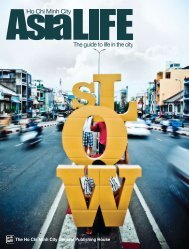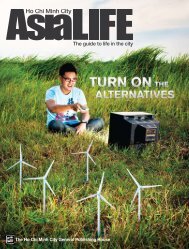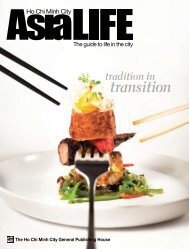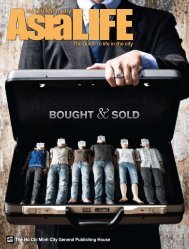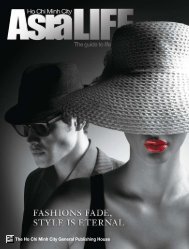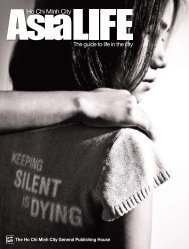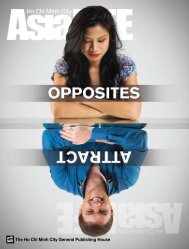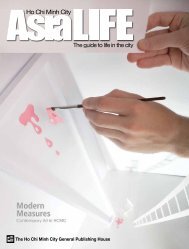asialife HCMC 1 - AsiaLIFE Magazine
asialife HCMC 1 - AsiaLIFE Magazine
asialife HCMC 1 - AsiaLIFE Magazine
Create successful ePaper yourself
Turn your PDF publications into a flip-book with our unique Google optimized e-Paper software.
given an Indian name—Chhatrapati<br />
Shivaji Maharaj Sangrahalaya)<br />
and the General Post<br />
Office (still called the GPO),<br />
the letterheads of all functionary<br />
offices could be changed.<br />
And they were, using ‘Mumbai’<br />
and making a lot of people<br />
for whom Bombay came more<br />
naturally, from individuals to<br />
companies like Bombay Dyeing,<br />
for instance, very unhappy.<br />
But the spirit of the city—call<br />
it Mumbai, officially, or Bombay<br />
—rises above and beyond its<br />
name. A visitor flying in at<br />
night will be able to look down<br />
to see a galaxy of lights of all<br />
colours, in a way symbolizing<br />
the many cultures and communities<br />
that have made the metropolis<br />
home. The airport is at<br />
the edge of Asia’s largest slum<br />
development—a paradox in<br />
itself—a maze of tiny alleyways<br />
winding through shanties piled<br />
willy-nilly around, above and<br />
alongside one another, where<br />
some of the most expensive<br />
products in the world are made<br />
for export to the west, from<br />
carpets to jewels to exquisitely<br />
worked garments to leather<br />
goods.<br />
Mumbai was originally a<br />
string of seven islands that<br />
have gradually been joined by<br />
causeways and reclamation<br />
of land from the sea to make<br />
one long, narrow collation<br />
of concrete structures. Often<br />
dubbed “city of gold,” the<br />
region is a destination for<br />
millions of migrant workers,<br />
from construction labourers<br />
to would-be-actors, who<br />
come to Mumbai to find their<br />
own Eldorado. Many have no<br />
homes, spending their lives on<br />
the streets, in dark warehouses<br />
or in slum colonies, which make<br />
a startling contrast to the towering<br />
luxury apartment blocks<br />
that tower overhead. The city is<br />
indeed a golden one, but only<br />
for a lucky few who have struck<br />
it rich and found super-success.<br />
It is also called the “city that<br />
never sleeps,” since the roads<br />
are rarely empty, business never<br />
stops and life is an endless<br />
circle.<br />
The city is a study in contradictions.<br />
South Mumbai, called<br />
SoBo by the young elite, has<br />
a high snob value. It is where<br />
the original wealthy folks built<br />
homes—many of these charming<br />
mansions and bungalows<br />
are now multi-storey apartment<br />
blocks where a single<br />
square foot of space is not just<br />
exorbitantly expensive, but<br />
rarely—if ever—available for<br />
sale. The city stretches long and<br />
narrow towards the western<br />
suburbs, known mainly for the<br />
film industry and its stars, or<br />
towards the foothills of the Deccan<br />
plateau, where a satellite<br />
city called Navi Mumbai (New<br />
Bombay) has taken root across<br />
the creek on to the mainland.<br />
Beaches edge much of the<br />
coastline, with treacherous<br />
quicksand and sharks making<br />
some of them dangerous, while<br />
others are dotted with tourists,<br />
<strong>asialife</strong> <strong>HCMC</strong> 47



